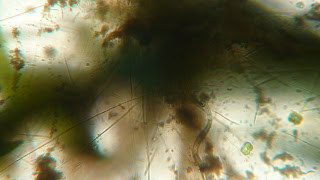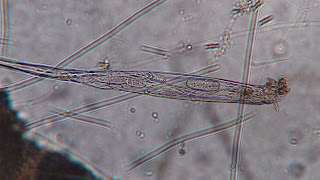Tuesday, November 18, 2008
Aquatic ecosystems lab week 4
As week 4 came upon my micro aquarium it became evident that life still survived, be it plant, animal, or microorganism. Perhaps the most interesting turn of events was the discovery that the large red midge, which was consuming many of the smaller organisms in the aquarium, was in fact dead and lying in the tank in two peaces. The organism probably died as a result of a lack of food. Even if the midge did manage to turn into a fly, as it would have in the wild, it would have most likely died due to the fact that my aquarium was sealed at the top. Life flourished near the midges corpse, many organisms were feeding off of its dead body such as Rotifers and Lycrymarias. The green plant life was still alive, due to ample H2O and its exposure to sunlight as per its placement near the window. The largest population explosion occured in the Rotifers, there were several hundred swimming around the midges corpse as well as several amoebas. there was a drastic decrease in the population of larger organisms such as nematodes or small multicelled creatures. Despite the large amount of decay occuring in the tank, life is still thriving. Though this microaquarium is only a small example of what an aquatic ecosystem may be like I believe that it has been a wonderful example of what a stagnant body of water's ecosystem may be like.
Sunday, November 9, 2008
Botany lab week 3
This week life still thrived in my micro aquarium, and it appears that the effects of the food pill that was added to it last week is still effecting the ecosystem. The insectivorous species of plant which i placed in the micro aquarium appears to be dying off, which follows the pattern of decay it has undergone since the beginning of this ecological ecosystem three weeks ago. Small projections from the plant now appear brown or dark blue rather than its original green color. The photosynthetic plant appears to be thriving this week, despite fluctuations in its health. Now it almost entirely consists of green plant matter probably due to the introduction of the food pill, and fresh oxygen due to the fact that the seal atop the micro aquarium fell off while i was not attending it. There was a large increase in the number of nematodes in the aquarium and many of them ventured outside of the muck at the bottom of the tank, finding their way up plant stalks and along the side of the tank. Perhaps the most astounding discovery of the week was an enormous Midge which was a leviathan in comparison to all the aquatic ecosystem's other organisms. Midges, or Aquatic Diptera are the most dominant insects in most small aquatic ecosystems and made up 40 percent of all aquatic insects (pg. 624, Ecology and Classification of North American Freshwater Invertebrates). After witnessing the size of this large red organism, it is difficult to believe that smaller organisms can exist is such a confined space with such a vevacious predator; the midge is obviously the most domminant consumer in my micro aquarium. This week provided many unusual supprises, i am becoming enthralled by the varying organisms encountered in this ecosystem.
Sunday, November 2, 2008
Botany lab week 2
Last week my micro aquarium began to slowly die as organisms started decaying. This week a food pill was added to my micro aquarium which caused many organisms to flourish. Green matter appeared to grow back in the dying plants and the the number of heterotrophic organisms increased dramatically. As it was last week, Rotifers were the most numerous organims in the ecosystem, and there were still large numbers of nematoeds. The most diverse organisms were found in the muck at the bottom of the container.
I encountered a vorticella, a common peritrich cilliate which contains wreaths of feeding cillia and an anchoring tail, which hung on the side of the container and filtered matter into its mouth, (Fig. 233 pg 113, Free Living Freshwater Organisms.)
I came upon an amoeba with many pseupodia which extended in all directions trapping engulfing matter which was found floating around the aquarium. After looking this amoeba up in a book I discovered that it is known as Biomyxa. A Biomyxa has thin anastomosing pseudopodia and is very enormous compared to other amoeba, it consumes alot of energy due to the quick rate in which it moves and the numerous pseudopodia which it extends, (Fig. 144, pg. 81 Free Living Freshwater Protozoa.)
The most interesting organism which i found was thrashing around violently in the muck. I descovered that it was a male cyclopoid, a multicellular organism with conspicuous antennae and two red eyespots which are very close together giving it the appearance of having one eye, hence the name, (Fig 95, pg. 204, Guide to Microlife.) As with last weeks observation, this week yielded valueable information in the understanding of my microecosystem
As with last weeks observation, this week yielded valueable information in the understanding of my microecosystem
I encountered a vorticella, a common peritrich cilliate which contains wreaths of feeding cillia and an anchoring tail, which hung on the side of the container and filtered matter into its mouth, (Fig. 233 pg 113, Free Living Freshwater Organisms.)

I came upon an amoeba with many pseupodia which extended in all directions trapping engulfing matter which was found floating around the aquarium. After looking this amoeba up in a book I discovered that it is known as Biomyxa. A Biomyxa has thin anastomosing pseudopodia and is very enormous compared to other amoeba, it consumes alot of energy due to the quick rate in which it moves and the numerous pseudopodia which it extends, (Fig. 144, pg. 81 Free Living Freshwater Protozoa.)

The most interesting organism which i found was thrashing around violently in the muck. I descovered that it was a male cyclopoid, a multicellular organism with conspicuous antennae and two red eyespots which are very close together giving it the appearance of having one eye, hence the name, (Fig 95, pg. 204, Guide to Microlife.)
 As with last weeks observation, this week yielded valueable information in the understanding of my microecosystem
As with last weeks observation, this week yielded valueable information in the understanding of my microecosystem
Tuesday, October 28, 2008
Botany Term Project Week 1
After many attempts to make it to the lab, i was able to observe my micro aquarium a few days ago. By the time i got there to observe it much had changed. The few plants which i added to the aquarium are were beginning to decay, and there was an obvious decrease in the amount of heterotrophic organisms from when i began this experiment; this may be due tho the lack of fresh oxygin. A decrease in the number of living organisms does not mean that their is no life, on the contrary, there was still a large number of living organisms to observe and green plant mater still existed. i did however encounter many nematodes which lived primarily in the muck. Nematodes are extremely common metazoans, which have along thin shape and move by writhing or gliding through the water (fig 18, pg. 28, Free-living Freshwater Protozoa).
 Perhapse the most interesting creature i saw while observing my microaquarium was Lycrymaria, spindle shaped cells which probe for food with an extendable neck (figure 301, pg 138. Free-living Freshwater Protozoa). I encountered this cell snatching materials out of the surrounding area with its long neck like protrusion.
Perhapse the most interesting creature i saw while observing my microaquarium was Lycrymaria, spindle shaped cells which probe for food with an extendable neck (figure 301, pg 138. Free-living Freshwater Protozoa). I encountered this cell snatching materials out of the surrounding area with its long neck like protrusion. The most common heterotrophic organisms i saw were Rotifers, which use cilia in the collection of food, which passes into the gut via two stout grinding plates called mastaz (Fig 15, pg 27 Freeliving Freshwater Protozoa).
The most common heterotrophic organisms i saw were Rotifers, which use cilia in the collection of food, which passes into the gut via two stout grinding plates called mastaz (Fig 15, pg 27 Freeliving Freshwater Protozoa).
In conclusion, it is obviouse that life will survive in even the most stressful environmants, i am looking forward to my next report.
Subscribe to:
Posts (Atom)